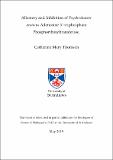Files in this item
Allostery and inhibition of Psychrobacter arcticus adenosine 5'-triphosphate phosphoribosyltransferase
Item metadata
| dc.contributor.advisor | Guimaraes da Silva, Rafael | |
| dc.contributor.author | Thomson, Catherine M. | |
| dc.coverage.spatial | xiv, 117 p. | en_US |
| dc.date.accessioned | 2020-02-07T16:45:12Z | |
| dc.date.available | 2020-02-07T16:45:12Z | |
| dc.date.issued | 2020-06-24 | |
| dc.identifier.uri | https://hdl.handle.net/10023/19430 | |
| dc.description.abstract | Allostery is the regulation of a protein by binding in an area distinct from the enzyme active site, but despite having clear applications in biotechnology and in drug discovery, elucidation of its complexities is still ongoing. Allostery can be either activating or inhibiting and the allosteric site is often distant to the one affected. The enzyme Psychrobacter arcticus ATP phosphoribosyl transferase (ATPPRT) is both allosterically activated and inhibited and is therefore useful as a model organism for understanding allostery. P. arcticus, ATPPRT is a Type IV ATPPRT, catalyzes the first step in histidine biosynthesis, and is comprised of two subunits: a short form HisG[sub]S and HisZ. HisG[sub]S is the catalytic domain and is allosterically activated by HisZ. HisZ also contains an allosteric binding site for inhibition by histidine. Short form HisG[sub]S alone is catalytically active but insensitive to histidine. This work establishes the kinetic mechanism of histidine inhibition in PaATPPRT, with histidine binding non-competitively with respect to both substrates (ATP and PRPP). AMP was confirmed as a competitive inhibitor with respect to both substrates for both PaATPPRT and PaHisGS and ADP was determined to be an alternative substrate. This work demonstrates the first example of histidine binding in a site analogous to that of HisRS in a short-form ATPPRT. It also highlights an interaction between two loops in PaHisZ, mediated by a hydrogen bond between Tyr263 and His104, that is likely to greatly reduce the probability of the complex sampling the activated conformation necessary for successful reaction. Additionally, a clear distinction between the activated form of PaATPPRT with ATP bound compared to all other structures is observed. Overall, this work demonstrates a clear reliance on key structural changes for the allosteric regulation of PaATPPRT. Attempts to purify Staphylococcus aureus ATPPRT were unsuccessful. | en_US |
| dc.language.iso | en | en_US |
| dc.publisher | University of St Andrews | |
| dc.title | Allostery and inhibition of Psychrobacter arcticus adenosine 5'-triphosphate phosphoribosyltransferase | en_US |
| dc.type | Thesis | en_US |
| dc.contributor.sponsor | Wellcome Trust. Institutional Strategic Support Fund (ISSF) | en_US |
| dc.type.qualificationlevel | Doctoral | en_US |
| dc.type.qualificationname | PhD Doctor of Philosophy | en_US |
| dc.publisher.institution | The University of St Andrews | en_US |
| dc.identifier.doi | https://doi.org/10.17630/10023-19430 |
This item appears in the following Collection(s)
Items in the St Andrews Research Repository are protected by copyright, with all rights reserved, unless otherwise indicated.

